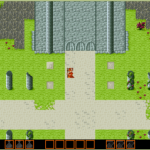 This post is about Soulcaster I, and how it evolved from the first stages. This was the first project I designed and built from scratch, and my philosophy has been to keep the design as minimal as possible. Rather than write a lengthy design document and try to detail all the enemies, their behaviors, the items, etc., I just jotted down some rough ideas and used it as a starting point. To be extra careful, I didn’t even use Word, I just did plain text in Notepad, and didn’t bother with formatting–or even capitalization. This was not intended to be a blueprint I would refer to throughout the project.
This post is about Soulcaster I, and how it evolved from the first stages. This was the first project I designed and built from scratch, and my philosophy has been to keep the design as minimal as possible. Rather than write a lengthy design document and try to detail all the enemies, their behaviors, the items, etc., I just jotted down some rough ideas and used it as a starting point. To be extra careful, I didn’t even use Word, I just did plain text in Notepad, and didn’t bother with formatting–or even capitalization. This was not intended to be a blueprint I would refer to throughout the project.
Here’s the original Story.txt, something I wrote after some prototyping a bit and discovering which 3 summons I needed. If you’ve played the game, you can get a sense for how different things really turned out.
travel to the cursed land of avericia in search of the mystic stone of rebirth. some say he who possesses this stone can begin life anew. with a lifetime of mage’s wisdom and the fire staff of alphos, you set out to pursue this myth. those who have ventured beyond the crypt of the damned have never returned. vicious monsters and the immortal spirits of the ancients stand guard. do you have the courage to embark on this quest?
act 1: crypt of the damned
floor 1: a grove in the forest reveals the entrance to a mighty stone edifice. step inside to face the first floor. a notification box displays the words “act 1: crypt of the damned” when the player enters.
floor 2: a tutorial sequence explains, without stopping gameplay, use x to fire. there can be a special character in the font that shows the x button like an xbox button, with color.
floor 3: after one floor of fighting weak mobs such as rats and bats, the second floor offers the first summon–the archer. pick up a glowing orb on an altar to get a scripted sequence (pausing gameplay) where the archer’s spirit talks to the player. “i took this road centuries ago, and the demon lord sealed my spirit in this orb. my soul cannot be released until this dungeon is destroyed. but take this soul orb. you can use it to summon a ghost in my image, and i will rain down arrows upon your foes. seek others like me along your way.”
a tutorial explains to use the A button to summon and Y to dispel summons.
by going through this sequence, the player gets the first soul orb and the ability to summon an archer. by picking up this orb, the door to the next dungeon opens.
floor 4: the next floor offers some scenarios where the archer totally owns. the first scroll is found at the end of the floor, and with it, a tutorial explaining how to use a scroll.
floor 5: following that floor, we introduce the merchant who offers some upgrades and new weapons. the player can’t afford everything just yet. this floor is more difficult due to the uprades the player will have bought. the merchant is at the start of the floor in case the player dies, he can try new upgrades and experiment.
floor 6: the final floor of the crypt act. the player gets the tank summon at the start and is put in some situations where he is very useful. the end of the floor has a merchant and it is obvious the door leads out of the crypt into the light.
when he gets the tank summon, it is explained that the B button switches the active summon.
act II: forgotten gardens
ruins, stone statues, overgrown pathways. tougher enemies. eventually get the bomber summon.
I don’t remember if I ever built a version of the game like this, but I definitely redid the first few levels many times before settling on what shipped in the game. I just loaded up an old build to grab some screens, so let’s take a look:





Next are a few maps that were only built to test the game mechanics. There were so many figures to tune, such as rate of fire, damage, interval for checking for targets… rooms like these helped me ensure each of the three summons had a unique purpose and could handle certain situations much better than the other two.
That’s all for now. If there’s some interest in this topic I can continue to dig stuff up, such as the original design document and maybe some screens or video of the early prototypes.




Definitely post more of this! I love Soulcaster II, and I’d like to hear more about your design process.
thanks for sharing this . Your game is awesome. please keep up the good work